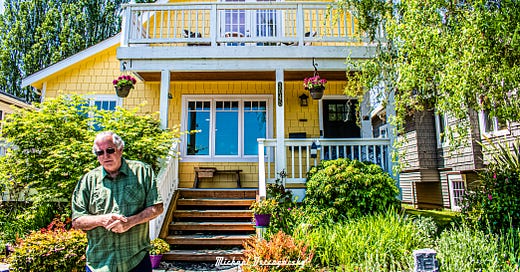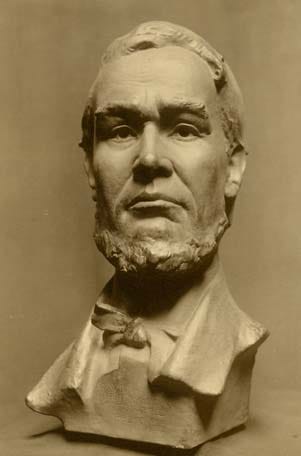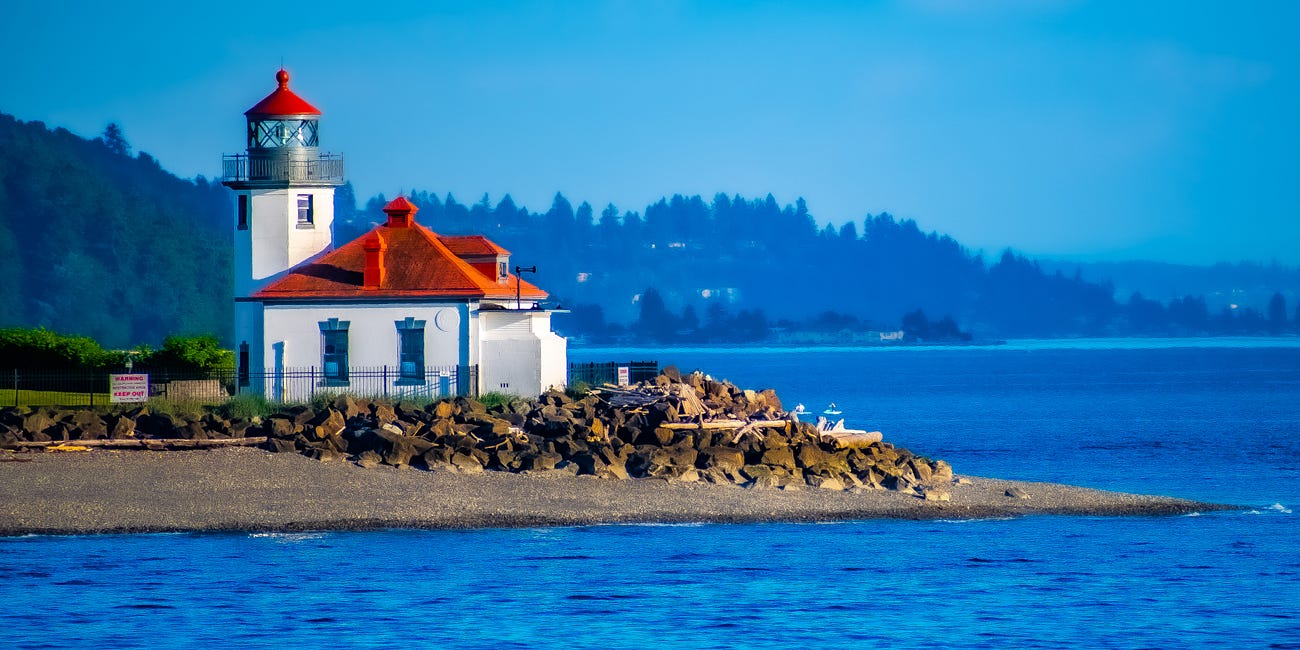Mardy Toepke, current owner of the Doc Maynard House who operates an Airbnb on the upper floor.
Dr. David Swinson Maynard bust by Seattle sculptor James A. Wehn created 1934 for Harborview Hospital. Photo courtesy Washington State History Museum Wehn Photograph Collection Item 1973.52.866.1.5.
David Swinson “Doc” Maynard (1808-1873) was a real physician, Seattle’s first. Top of his class at his home state of Vermont’s Castleton Medical School. He didn’t just play a physician in a frontier Western. Doc Maynard also served as Seattle’s second lawyer (when the first died, Maynard devoured a pile of law books and passed the bar), King County’s Justice of the Peace, postmaster, Indian agent, storekeeper, and most famously close friend to Duwamish Chief Seattle (spelled Si'ahl in modern Duwamish spelling, equivalent to the modern Lushootseed language spelling siʔaɫ, also transcribed as Sealth, Seathl or See-ahth). Maynard named his store the Seattle Exchange in honor of the chief.
When the Arthur Denny Party decamped from Alki Point where they originally landed November 13, 1851,
See my story of the Alki landing here:
Alki Point Lighthouse
West Seattle’s 1913 Alki Point Lighthouse established on sacred Duwamish ground. Thanks for reading Michael’s Substack! Subscribe for free to receive new posts and support my work. The Arthur Denny Party including ten adults and twelve children, originally from Illinois, intent on finding land for a new settlement, came ashore at Alki Point November 13, 1…
to move across Elliott Bay to today’s Pioneer Square in 1852, they adopted the traditional Duwamish name for their new settlement. An old Duwamish village with a heavily used trail starting at the site connected Elliott Bay to Lake Washington, so the Duwamish called the place Little Crossing-Over Place, Tsehalalitch. Eventually a myth came to be written into popular history that the town had been named Duwamps or Dewampsh (a corruption of Duwamish, a story for another time). Doc Maynard convinced his fellow settlers to name the town after Chief Seattle, and on May 23, 1853 Doc Maynard, Arthur Denny, and Charles Boren filed a town plan for the town of Seattle.
Doctor David Swinson Maynard is my favorite character in Seattle history. Loved women and booze about equally. Established Seattle's first hospital as well as first brothel! Apparently a lady's man. Once famously paraded through downtown Seattle with not just one but two wives, one on each arm. He never quite finished divorcing his first wife before marrying his second. He convinced the Oregon Territorial Legislature to enact unprecedented legislation granting him a divorce from his first.
At age twenty Maynard married Lydia A. Rickey. They had a couple of children, Frances and Henry. He moved the family to Cleveland to open a medical school. The good doctor made and lost several fortunes. The medical school folded during the Panic of 1837. Maynard discovered in 1841 that Lydia proved faithless in marriage, but stuck with her until 1850. Then the lure of the California Gold Rush drew him to the West. While Maynard promised to send for the family once he found a new home, he hoped that Lydia would take the opportunity of his desertion to divorce him.
Doc Maynard joined a wagon train bound for California. The leader of another wagon train bound for Oregon Territory died and Maynard found himself wagon master. He ended up in Puget Sound far from the California gold fields in the new settlement of Olympia. The reason being because he met and fell in love with a widow named Catherine Troutman Broshears. She headed to Olympia with her brother Mike Simmons who planned to open Puget Sound’s first store. Maynard ended up in Olympia in the hopes of marrying Catherine.
In Olympia Doc Maynard met the Duwamish Chief Seattle. Chief Seattle had been a habitué of the British Hudson’s Bay Company Nisqually House since the 1830s, which had been located near the new settlement of Olympia. Enthralled with European/American culture and technology, the chief favored friendship and trade with the white settlers overrunning his homelands. He courted settlers he believed could help secure favorable relations between white settlers and his Duwamish people. He must have recognized the energy and initiative that Doc Maynard demonstrated might be key to securing his people’s fortunes and future. The two became fast friends.
Chief Seattle personally paddled Doc Maynard in his canoe to deposit him at Alki Point March 1852 to meet another white friend, Arthur Denny, at the new settlement of New York Alki, just in time to join the Denny Party in their move across Elliott Bay. There, under the provisions of the Oregon Donation Land Claim Act of 1850, Maynard, as a still legally married man, selected 640 acres of land encompassing today’s Pioneer Square district.
Maynard proved to be the oil to the Denny Party’s water. He was everything they were not. A drinker not a teetotaling puritan. A womanizer who went into business with prostitutes, believing thriving frontier towns deserved bars and brothels. A friend to the Duwamish, not someone who considered the Duwamish to be a necessary nuisance. By 1857 Maynard had had enough. He traded the remaining 260 acres of his Seattle claim for Charles Terry’s Alki Point claim. The town the Denny Party established on Alki Point in 1851 grandiosely named New York had become New York Alki (by and by or eventually) and finally just Alki as the reality set in that the townsite of Seattle was better situated for economic prosperity. Maynard established a potato farm on the townsite using Alki Beach kelp for fertilizer and assumed the life of a gentleman farmer.
A cabin Doc Maynard constructed burned to the ground in 1858. By 1860 Maynard constructed the clapboard house known today as the Doc Maynard House on Alki Beach at the foot of today’s 64th Avenue SW. David and Catherine lived in the house until 1868 when Maynard finally realized Seattle is poor potato country. As a good friend of Doc Maynard’s, no doubt Chief Seattle himself walked the floors of the home before his death in 1866. Maynard sold the Alki claim in 1868 to Hans Hanson, grandfather to Seattle folk singer and restauranteur Ivar Haglund, to return to downtown Seattle to open Seattle’s first hospital.
The Doc Maynard House remained on Alki Beach until 1905. That year, two years before Seattle annexed West Seattle, King County started construction of Alki’s first major road along the beach, the forerunner to Alki Avenue. Before, Alki Beach was basically the road. Houses along the beach, such as Maynard’s, had to be moved or demolished. The Doc Maynard House was moved one block east and reoriented to face newly platted 64th Avenue SW. Sometime after the relocation, what had been the south wing of the building, then the west wing, was removed. The home was lovingly restored in 2019 by current owner Mardy Toepke who hosted a gathering at the home of descendants of both Chief Seattle and Doc Maynard.
As an end note, let me add a nod to the collection of thirty-two letters acquired by the Southwest Seattle Historical Society in 2020, written by Doc Maynard and his wife Catherine from 1850 to 1893 and sent to his son Henry. The letters were donated by a group of cousins descended from Henry Maynard.







